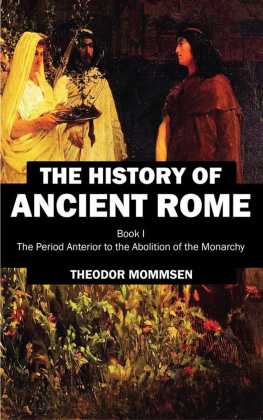Theodor Mommsen - The History of Rome. Book III
Here you can read online Theodor Mommsen - The History of Rome. Book III full text of the book (entire story) in english for free. Download pdf and epub, get meaning, cover and reviews about this ebook. genre: Science. Description of the work, (preface) as well as reviews are available. Best literature library LitArk.com created for fans of good reading and offers a wide selection of genres:
Romance novel
Science fiction
Adventure
Detective
Science
History
Home and family
Prose
Art
Politics
Computer
Non-fiction
Religion
Business
Children
Humor
Choose a favorite category and find really read worthwhile books. Enjoy immersion in the world of imagination, feel the emotions of the characters or learn something new for yourself, make an fascinating discovery.

- Book:The History of Rome. Book III
- Author:
- Genre:
- Rating:3 / 5
- Favourites:Add to favourites
- Your mark:
- 60
- 1
- 2
- 3
- 4
- 5
The History of Rome. Book III: summary, description and annotation
We offer to read an annotation, description, summary or preface (depends on what the author of the book "The History of Rome. Book III" wrote himself). If you haven't found the necessary information about the book — write in the comments, we will try to find it.
The History of Rome. Book III — read online for free the complete book (whole text) full work
Below is the text of the book, divided by pages. System saving the place of the last page read, allows you to conveniently read the book "The History of Rome. Book III" online for free, without having to search again every time where you left off. Put a bookmark, and you can go to the page where you finished reading at any time.
Font size:
Interval:
Bookmark:
version="1.0" encoding="windows-1251"?>sci_historysci_cultureTheodorMommsenThe History of Rome. Book III
The History of Rome by Theodor Mommsen, translated by William Purdie Dickson
endeBenjaminShoomowFB Writer v1.1, FB Editor v2.024 July 2009A3F00DFE-B0AC-47E1-BDBF-015B65E1355A1.0Ver 1.0 - , (The Project Gutenberg, www.gutenberg.net). (David Ceponis). , , , -xxx- --xxx-- .
Theodor Mommsen
History of Rome. Book III
THE HISTORY OF ROME. BOOK III
From the Union of Italy to the Subjugation of Carthage and the Greek States
by THEODOR MOMMSEN
Translated with the Sanction of the Author By William Purdie Dickson, D.D., LL.D. Professor of Divinity in the University of Glasgow
A New Edition Revised Throughout and Embodying Recent Additions
Preparer's Note
This work contains many literal citations of and references to foreign words, sounds, and alphabetic symbols drawn from many languages, including Gothic and Phoenician, but chiefly Latin and Greek. This English Gutenberg edition, constrained to the characters of 7-bit ASCII code, adopts the following orthographic conventions:
1) Except for Greek, all literally cited non-English words that do not refer to texts cited as academic references, words that in the source manuscript appear italicized, are rendered with a single preceding, and a single following dash; thus, -xxxx-.
2) Greek words, first transliterated into Roman alphabetic equivalents, are rendered with a preceding and a following double-dash; thus, --xxxx--. Note that in some cases the root word itself is a compound form such as xxx-xxxx, and is rendered as --xxx-xxx--
3) Simple unideographic references to vocalic sounds, single letters, or alphabeic dipthongs; and prefixes, suffixes, and syllabic references are represented by a single preceding dash; thus, -x, or -xxx.
4) (Especially for the complex discussion of alphabetic evolution in Ch. XIV: Measuring And Writing). Ideographic references, meaning pointers to the form of representation itself rather than to its content, are represented as -"id:xxxx"-. "id:" stands for "ideograph", and indicates that the reader should form a picture based on the following "xxxx"; which may be a single symbol, a word, or an attempt at a picture composed of ASCII characters. E. g. -"id:GAMMA gamma"- indicates an uppercase Greek gamma-form followed by the form in lowercase. Some such exotic parsing as this is necessary to explain alphabetic development because a single symbol may have been used for a number of sounds in a number of languages, or even for a number of sounds in the same language at different times. Thus, -"id:GAMMA gamma" might very well refer to a Phoenician construct that in appearance resembles the form that eventually stabilized as an uppercase Greek "gamma" juxtaposed to one of lowercase. Also, a construct such as -"id:E" indicates a symbol that with ASCII resembles most closely a Roman uppercase "E", but, in fact, is actually drawn more crudely.
5) Dr. Mommsen has given his dates in terms of Roman usage, A.U.C.; that is, from the founding of Rome, conventionally taken to be 753 B. C. The preparer of this document, has appended to the end of each volume a table of conversion between the two systems.
CONTENTS
BOOK III: From the Union of Italy to the Subjugation of Carthage and the Greek States
I. Carthage
II. The War between Rome and Carthage Concerning Sicily
III. The Extension of Italy to Its Natural Boundaries
IV. Hamilcar and Hannibal
V. The War under Hannibal to the Battle of Cannae
VI. The War under Hannibal from Cannae to Zama
VII. The West from the Peace of Hannibal to the Close of the Third Period
VIII. The Eastern States and the Second Macedonian War
IX. The War with Antiochus of Asia
X. The Third Macedonian War
XI. The Government and the Governed
XII. The Management of Land and of Capital
XIII. Faith and Manners
XIV. Literature and Art
BOOK THIRD
From the Union of Italy to the Subjugation of Carthage and the Greek States
Arduum res gestas scribere.
SallustChapter I
Carthage
The Semitic stock occupied a place amidst, and yet aloof from, the nations of the ancient classical world. The true centre of the former lay in the east, that of the latter in the region of the Mediterranean; and, however wars and migrations may have altered the line of demarcation and thrown the races across each other, a deep sense of diversity has always severed, and still severs, the Indo-Germanic peoples from the Syrian, Israelite, and Arabic nations. This diversity was no less marked in the case of that Semitic people which spread more than any other in the direction of the west - the Phoenicians. Their native seat was the narrow border of coast bounded by Asia Minor, the highlands of Syria, and Egypt, and called Canaan, that is, the "plain". This was the only name which the nation itself made use of; even in Christian times the African farmer called himself a Canaanite. But Canaan received from the Hellenes the name of Phoenike, the "land of purple", or "land of the red men", and the Italians also were accustomed to call the Canaanites Punians, as we are accustomed still to speak of them as the Phoenician or Punic race.
Their CommerceThe land was well adapted for agriculture; but its excellent harbours and the abundant supply of timber and of metals favoured above all things the growth of commerce; and it was there perhaps, where the opulent eastern continent abuts on the wide-spreading Mediterranean so rich in harbours and islands, that commerce first dawned in all its greatness upon man. The Phoenicians directed all the resources of courage, acuteness, and enthusiasm to the full development of commerce and its attendant arts of navigation, manufacturing, and colonization, and thus connected the east and the west. At an incredibly early period we find them in Cyprus and Egypt, in Greece and Sicily, in Africa and Spain, and even on the Atlantic Ocean and the North Sea. The field of their commerce reached from Sierra Leone and Cornwall in the west, eastward to the coast of Malabar. Through their hands passed the gold and pearls of the East, the purple of Tyre, slaves, ivory, lions' and panthers' skins from the interior of Africa, frankincense from Arabia, the linen of Egypt, the pottery and fine wines of Greece, the copper of Cyprus, the silver of Spain, tin from England, and iron from Elba. The Phoenician mariners brought to every nation whatever it could need or was likely to purchase; and they roamed everywhere, yet always returned to the narrow home to which their affections clung.
Their Intellectual EndowmentsThe Phoenicians are entitled to be commemorated in history by the side of the Hellenic and Latin nations; but their case affords a fresh proof, and perhaps the strongest proof of all, that the development of national energies in antiquity was of a one-sided character. Those noble and enduring creations in the field of intellect, which owe their origin to the Aramaean race, do not belong primarily to the Phoenicians. While faith and knowledge in a certain sense were the especial property of the Aramaean nations and first reached the Indo-Germans from the east, neither the Phoenician religion nor Phoenician science and art ever, so far as we can see, held an independent rank among those of the Aramaean family. The religious conceptions of the Phoenicians were rude and uncouth, and it seemed as if their worship was meant to foster rather than to restrain lust and cruelty. No trace is discernible, at least in times of clear historical light, of any special influence exercised by their religion over other nations. As little do we find any Phoenician architecture or plastic art at all comparable even to those of Italy, to say nothing of the lands where art was native. The most ancient seat of scientific observation and of its application to practical purposes was Babylon, or at any rate the region of the Euphrates. It was there probably that men first followed the course of the stars; it was there that they first distinguished and expressed in writing the sounds of language; it was there that they began to reflect on time and space and on the powers at work in nature: the earliest traces of astronomy and chronology, of the alphabet, and of weights and measures, point to that region. The Phoenicians doubtless availed themselves of the artistic and highly developed manufactures of Babylon for their industry, of the observation of the stars for their navigation, of the writing of sounds and the adjustment of measures for their commerce, and distributed many an important germ of civilization along with their wares; but it cannot be demonstrated that the alphabet or any other of those ingenious products of the human mind belonged peculiarly to them, and such religious and scientific ideas as they were the means of conveying to the Hellenes were scattered by them more after the fashion of a bird dropping grains than of the husbandman sowing his seed. The power which the Hellenes and even the Italians possessed, of civilizing and assimilating to themselves the nations susceptible of culture with whom they came into contact, was wholly wanting in the Phoenicians. In the field of Roman conquest the Iberian and the Celtic languages have disappeared before the Romanic tongue; the Berbers of Africa speak at the present day the same language as they spoke in the times of the Hannos and the Barcides.
Next pageFont size:
Interval:
Bookmark:
Similar books «The History of Rome. Book III»
Look at similar books to The History of Rome. Book III. We have selected literature similar in name and meaning in the hope of providing readers with more options to find new, interesting, not yet read works.
Discussion, reviews of the book The History of Rome. Book III and just readers' own opinions. Leave your comments, write what you think about the work, its meaning or the main characters. Specify what exactly you liked and what you didn't like, and why you think so.





